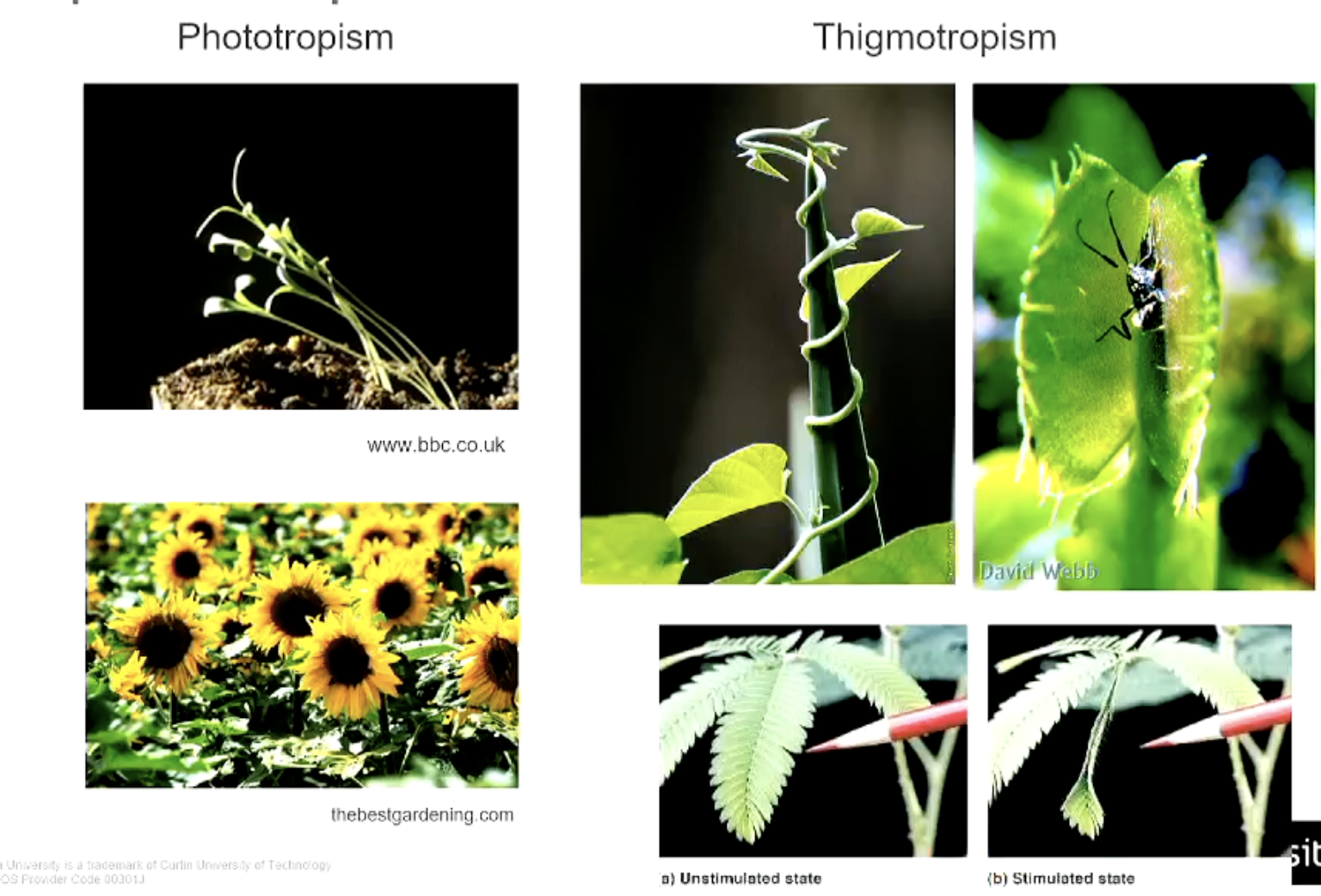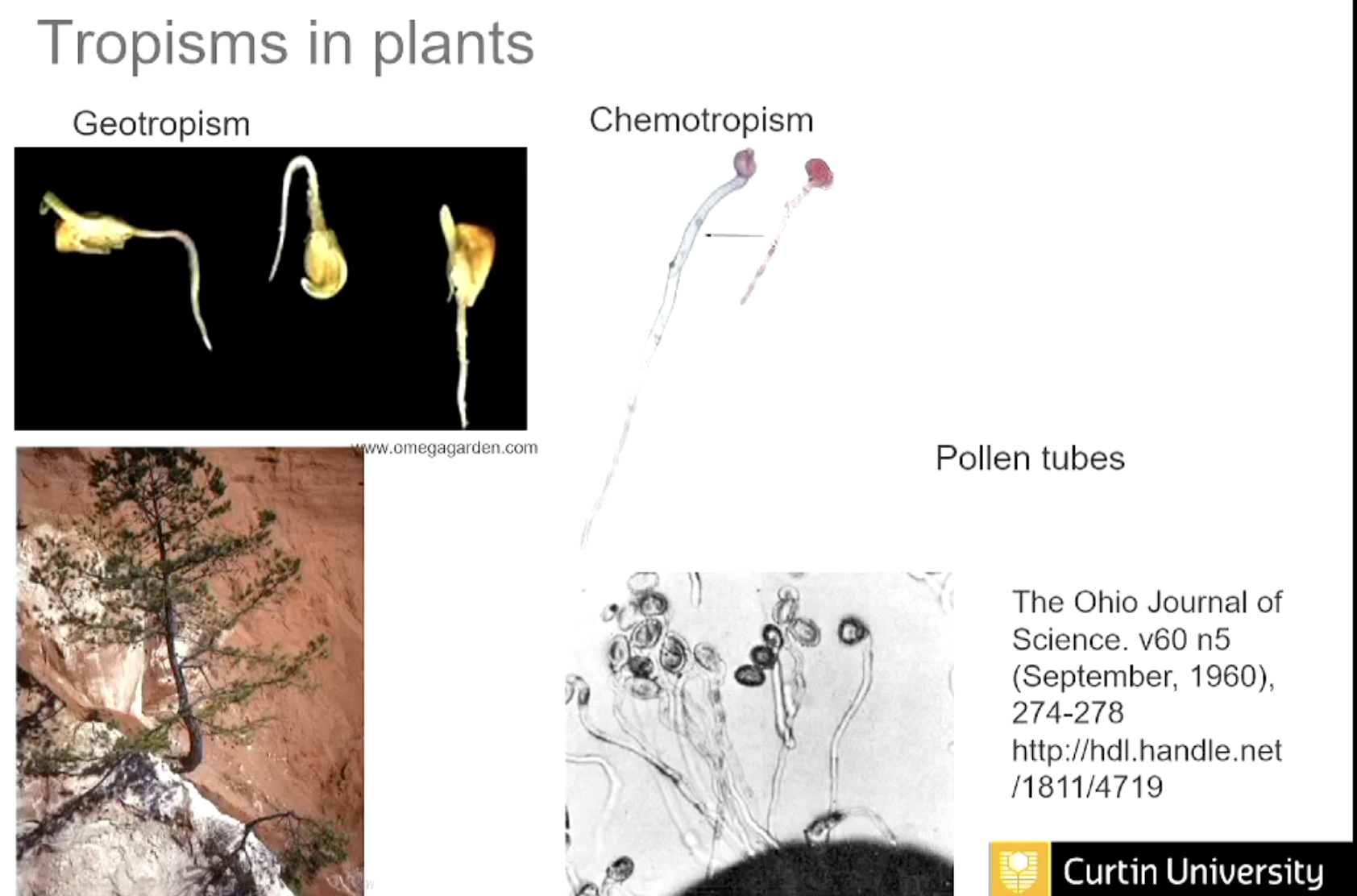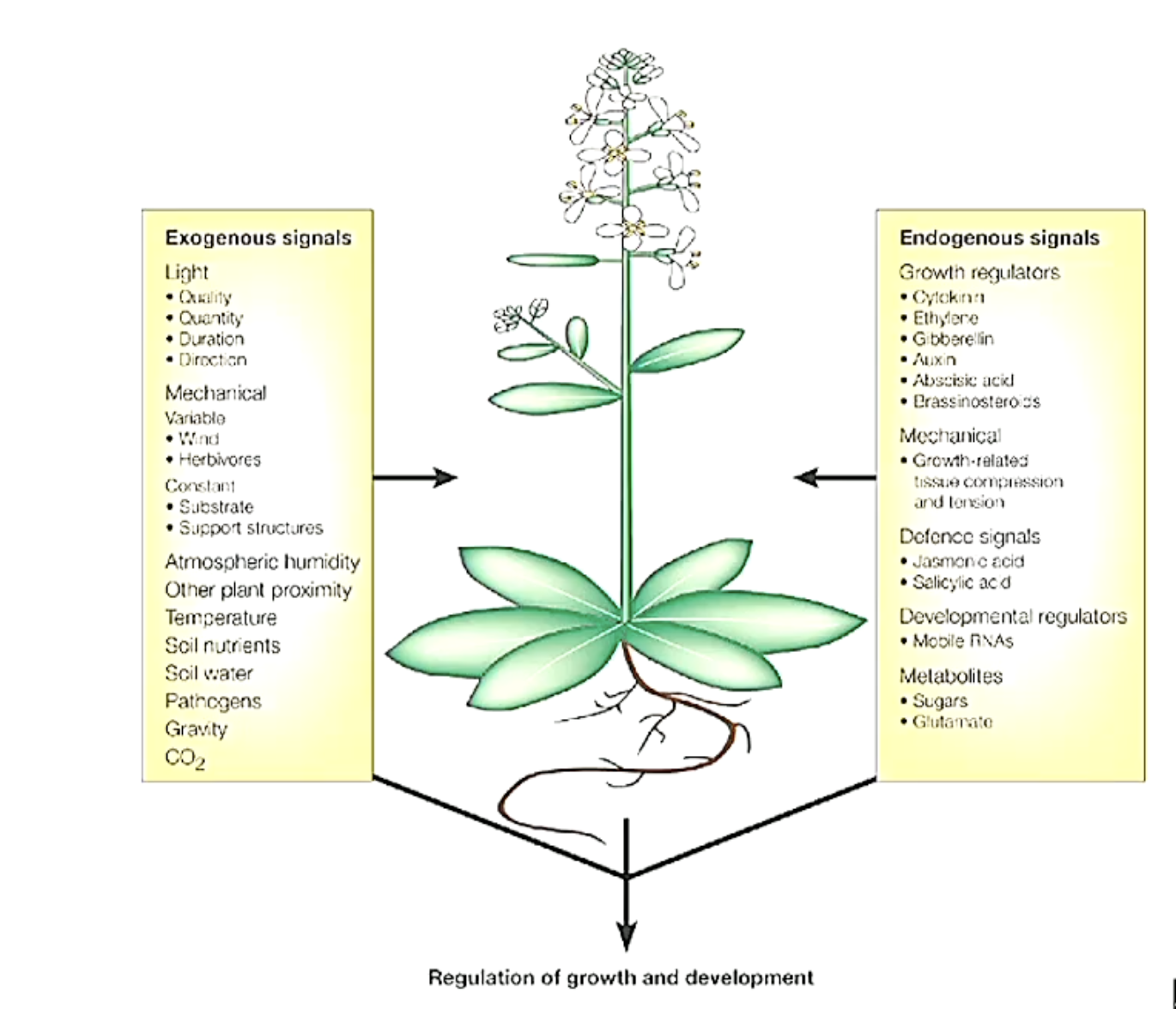T10: Coordination and Response in Plants
1/30
There's no tags or description
Looks like no tags are added yet.
Name | Mastery | Learn | Test | Matching | Spaced |
|---|
No study sessions yet.
31 Terms
what does response involve?
Reaction to a stimulus
Internal
External
what does communication involve?
Communication method may be:
Electrical
Chemical
Both
what are other words used instead of communication and response?
Responsiveness, sensitivity, response to stimuli, irritability
what do plants respond to?
Response to………
Light
Temperature
Carbon dioxide
Water availability
Nutrient availability
Damage
what is cell to cell communication?
Communication between individual cells, often involving signaling molecules and receptors that facilitate responses to environmental changes.
Occurs in unicellular and multicellular organisms
what is cell to cell communication like in multicellular organisms?
In multicellular organisms coordination is achieved by response to:
External signals
Cell to cell signals
Plasmodesmata (singular: plasmodesma) are microscopic channels which traverse the cell walls of plant cells and some algal cells, enabling transport and communication between them.
Channels between cells allow flow of cytoplasm
what is long distance signalling?
Long distance signalling
Animals and plants use molecules produced by one cell and utilised by another at a distance from site of production = hormones
Movement through utilises transport systems or cell to cell transfer
Animals = endocrine system (circulatory system)
Plants = plant growth regulators (cell to cell + vessels)
what is ultimate communication (programmed cell death)?
Cellular apoptosis
Cells can trigger an end = programmed cell death
Damage
Infection
Age of cell
Cells internally destroys itself – DNA disrupted
Cell components destroyed
Scavenger cells engulf and digest components – protection of neighbouring cells
Involvement in degenerative diseases – Parkinson’s, Alzheimer’s
Failure of mechanisms – tumours and cancers
what is communication in plants like?
Sessile organisms need response mechanisms
No ability to move away from stimulus
Responses:
Direction of growth (e.g. light)
Patterns of growth (e.g. drought)
Seed dispersal and timing
Stress response
Warning!!
-- often slower than animal responses
what are tropisms?
Tropisms
Growth of plant in RESPONSE to a unidirectional EXTERNAL stimulus
Involves growth (differential?) of part(s)
Growth response is slow/irreversible
Hormonal coordination influences response
what are positive/negative tropisms?
Positive tropism - towards the stimulus
Negative tropism - away from the stimulus
what are examples of stimulus that cause tropism?
Stimuli include:
Gravity (gravitropism or geotropism)
Light (phototropism)
Sun's angle (heliotropism)
Solid objects (thigmotropism)
Chemicals (chemotropism)
what are the different types of tropism?
Gravity (gravitropism or geotropism)
Light (phototropism)
Sun's angle (heliotropism)
Solid objects (thigmotropism)
Chemicals (chemotropism)
example of phototropism and thigmotropism
Phototropism is when plants bend toward light sources, while thigmotropism is the growth response of plants to physical contact with objects.

example of geotropism and chemotropism
Geotropism is the directional growth of a plant in response to gravity, while chemotropism is the growth response of plants to chemicals in their environment.

what did research between pea plants uncover about communication between plants?
Research with pea plants:
Planted close but not touching
Soil – shared or not shared
Water stress applied
Water-stressed plants closed stomata
Non-water stressed plants sharing soil – closed stomata
Non-water stressed plants in separate soil – no response
how do plants communicate between one another?
Chemical signals – eg hormones and volatile gases
Eg cabbages produce methyl jasmonate as a warning system
Undamaged plants may respond to signals from neighbouring plants and increase resistance (eg wild tobacco and clipped sagebrush)
what are plant hormones and what do they do?
Occur in low concentrations
Located in different parts of the plant
Are mobile
Affect growth and development of plants
Actions are varied:
Alter gene expression
Alter enzyme activity
Changing membrane properties
Effects include:
Increase/decrease in cell division
Cell elongation
Cell differentiation
Known as 'plant growth regulators' – modify the physiological processes involved in plant growth
Earliest recognition of control mechanisms – 1800’s (Charles Darwin)
Observed directional changes in growth
Appeared to be induced by light
what are the 5 plant hormones?
auxins
cytokinins
Gibberellins
abscisic acid
ethylene
what are auxins and what do they do?
Produced in apical meristems (roots and shoots) and young leaves
Responsible for elongation of coleoptiles
Stimulates root and shoot growth
Regulates fruit development
Functional in directional growth 1 (tropisms)
what do auxins do in more detail?
Auxins (IAA)
Transported at ~10mm/hr
Move through adjacent parenchyma cells (unidirectional)
Increases proton pump activity at cell wall → increased accumulation of H+ ions
→ decreased pH (increased acidity)
→ Some cell wall breakdown
→ Increased water uptake, increased elasticity → elongation
Alters gene expression
→ protein manufacture
what is the commercial use of auxins?
Synthetic auxins are available
Include 2,4 – dichlorophenoxyacetic acid (2,4-D)
Often used as herbicides
Mimic activity of IAA and bind to enzyme active sites
Used for broadleaf weeds (dicots) not monocots
Prevention of fruit and leaf drop
Increase fruit size (citrus)
Producing seedless fruit from unpollinated flowers (greenhouse tomatoes)
what are cytokinins and what do they do?
Cytokinins (1940s)
Compounds related to adenine (DNA base)
Increase cell division → associated with plant growth
Produced in roots and translocated to other actively growing tissues
Responsible for increasing leaf size (cell expansion)
Promotes lateral root growth rather than primary growth
Responsible for nodulation in legumes
Ratio of auxin:cytokinin → effects change from size increase to cell differentiation
how can cytokinin and auxin interact?
Active apical bud suppresses growth of lateral buds (auxin production)
Auxins inhibit lateral bud development
Removal of apical meristem = removal of auxin production?
what is the commercial use of cytokinins?
Commercial Use of Cytokinins
Not as widespread as auxins – fewer commercial applications
Reducing leaf aging – leaves stay green longer (florists, vegetables)
Tissue culture for mass production of plants – promotes bud and shoot growth
Breaking seed dormancy (some)
what are gibberellins and what do they do?
Gibberellins (1930-1950)
Linked with rice plants becoming tall and spindly due to hyper-elongation of stems
Produced by a fungus (Fusarium spp)
Found to occur naturally in plants
Stimulate stem growth through division and elongation
Dwarf plants + GA achieve normal size
Produced after water uptake by seed – may break dormancy in some seeds
what is the commercial use of gibberellins?
Commercial Use of Gibberellins
Increase fruit size (grapes, tomatoes)
Increase internodal space on grape bunch
Delay ripening (fruit storage)
what is abscisic acid and what does it do?
Abscisic acid (1960s)
ABA slows growth!
Often antagonises actions of other hormones. Ratio of ABA will determine final physiological outcome
Functions include:
Inhibits germination
Aids seed survival
Enables drought survival
what is ethylene and what does it do?
Ethylene (Ethene) (1930s)
Only volatile (gas) hormone
Made by most tissues in the plant – higher levels in older tissues
Key areas of function:
Stress responses – waterlogging, drought, temperature, insect attack, grazing
Ripening of fruit
Apoptosis
Senescence of plant tissue → programmed cell death (apoptosis)
[Ethylene] increases and alters gene expression → new enzymes → breakdown
Leaf drop associated with weakening of cells and breakage
what are exogeneous vs endogeneous signals?
Exogenous signals are external environmental factors that affect a plant's growth and behavior, such as light, temperature, and water availability.
Endogenous signals are internal factors, including hormones and signaling molecules produced by the plant itself, which regulate growth and responses.
